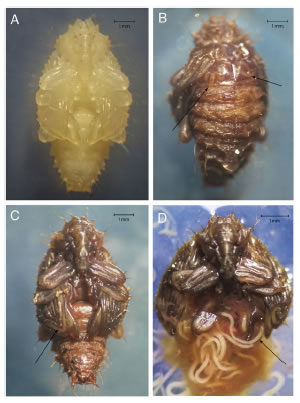Bacteria of the genus Photorhabdus (Enterobacteriaceae) are motile, gram negative, symbiotically associated with infective juveniles of entomopathogenic nematodes of the genus Heterorhabditis (Heterorhabditidae). Nematodes retain the Photorhabdus bacterial cells in their intestine and transport them into an insect host6. Upon locating an insect host, the nematode of the genus Heterorhabditis penetrates through natural openings (mouth, anus, spiracles)1, or directly into the hemocoel via the integument, subse-quently releasing bacteria into the hemolymph4. Once in the hemolymph, bacterium of the genus Photorhabdus begins to multiply simultaneously releasing toxins virulent enough to kill the insect within 24 h2. Phyrdenus muriceus (Coleoptera: Curculionidae) is a pest of cultivated Solanaceae affecting egg-plant, potato and tomato. Considerable damages on these crops are produced by this pest affecting both the aerial and underground parts of the plants3,5. Infectivity of the entomopathogenic complex Heterorhabditis bacteriophora and the symbiotic bacterium Photorhabdus luminescens isolated from soil samples collected from an orchard of La Plata was tested against pupae of P. muriceus. This stage was considered to be a suitable target to control in the field due to its permanence in the soil. Plastic contain-ers (8.5 cm diameter x 5.5 cm height) were used with sterile soil forming a 2cm high layer. Pupae were added to the soil surface and exposed to a concentration of 5000 infective juveniles (IJs)/insect. Seventy percent (70%) mortality (n = 10) occurred at 48 h after infection. In Figure 1, we can observe nematodes inside the body of the pupae (B and C). The cadavers showed the typical red wine coloration due to the release of the endosymbiotic bacteria in the hemo-coel (Figs. 1B-D) unlike non-parasitized pupae (Fig. 1A). The nematode-bacterium complex was effective to parasitize and kill R muriceus pupae. Future studies should be carried out to determine its use as biological control for this horticultural pest.

Figure 1: Image of pupae of Phyrdenus muriceus taken with an Olympus DP-71 camera. (A) Pupa with noinfection. (B) Dorsal view of infected pupa with nematodes inside the body (arrows). (C) Ventral view of infected pupa with nematodes inside the body (arrows). (D) Emerging nematodes from the lesion of the tegument (arrow).
Conflict of interest
The authors declare that they have no conflicts of interest.












 uBio
uBio 

